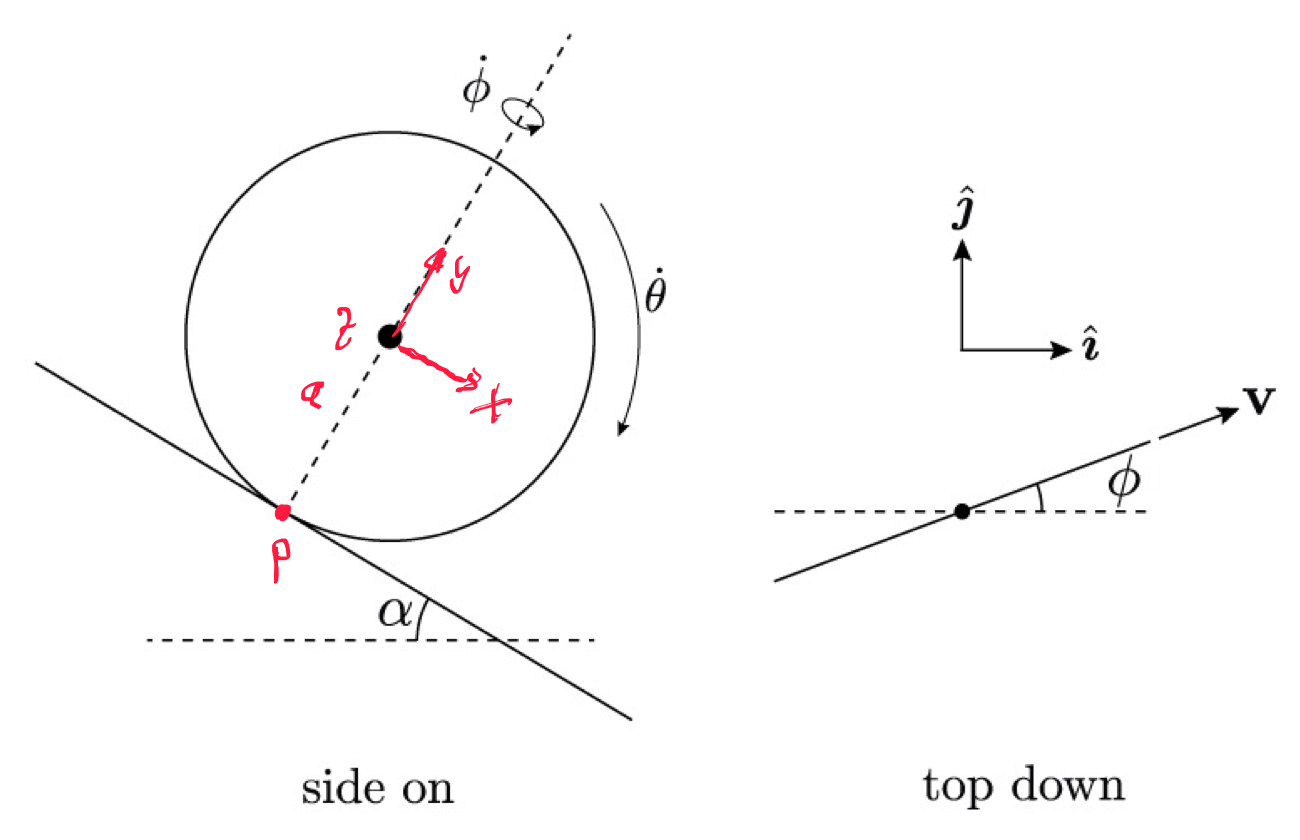$ \def \b {\mathbf}$
The Rotation Matrix between the wheel coordinate system and inertial system is:
\begin{align*} &\b R=\b R_y(\phi)\,\b R_z(\theta) \end{align*} form here you obtain the angular velocity $~\b\omega~$ given in wheel system \begin{align*} &\b \omega= \left[ \begin {array}{c} \sin \left( \theta \right) \dot\phi \\\cos \left( \theta \right) \dot\phi \\\dot\theta \end {array} \right] \end{align*}
The rolling conditions
\begin{align*} &\b v_r=\begin{bmatrix} \dot{x} \\ \dot{y} \\ \dot{z} \\ \end{bmatrix}+\b R\,\b\omega\times\left( \b R_y(\phi)\,\begin{bmatrix} 0 \\ -a \\ 0 \\ \end{bmatrix} \right)=\begin{bmatrix} 0 \\ 0 \\ 0 \\ \end{bmatrix}\\ &\dot{x}+\cos(\phi)\,a\,\dot{\theta}=0\\ &\dot{y}=0\\ &\dot{z}-\sin(\phi)\,a\,\dot{\theta}=0 \end{align*}
where $~\dot x~,\dot y~,\dot z~$ are the velocities given in inertial system
the position vector of the wheel center given in inertial system is:
\begin{align*} &\b P=\begin{bmatrix} x \\ 0 \\ z \\ \end{bmatrix}+\b R_y(\phi)\,\b R_z(\alpha)\,\begin{bmatrix} 0 \\ -a \\ 0 \\ \end{bmatrix} =\begin{bmatrix} x \\ 0 \\ z \\ \end{bmatrix}+\left[ \begin {array}{c} \cos \left( \phi \right) \sin \left( \alpha \right) a\\-\cos \left( \alpha \right) a \\-\sin \left( \phi \right) \sin \left( \alpha \right) a\end {array} \right] \end{align*} thus the potential energy $~U=-m\,g\,\left(\b P\right)_z~$$~U=-m\,g\,\left(\b P\right)_y=-m\,g\,a\,\cos(\alpha)~$
Notice
the contact point $~p~$ must "remain" on the plane ($~\b R_z(\theta)\mapsto \b R_z(0)~$)
equations of motion
with \begin{align*} &\b q=\begin{bmatrix} x \\ y \\ z \\ \phi \\ \theta \\ \end{bmatrix} \end{align*}
and the nonholonomic constraint equations $~\b v_r=0~$
you obtain the kinetic energy
$$T=\frac m2\,\b v\cdot\b v+\frac 12 \b\omega ^T\,\b I\,\b \omega+\b\lambda\,\cdot \b v_r$$
where $~\b v=[~\dot x~,\dot y~,\dot z~]^T~$ and $~\b\lambda= [~\lambda_1~,\lambda_2~\lambda_3]^T~$ Lagrange multipliers

